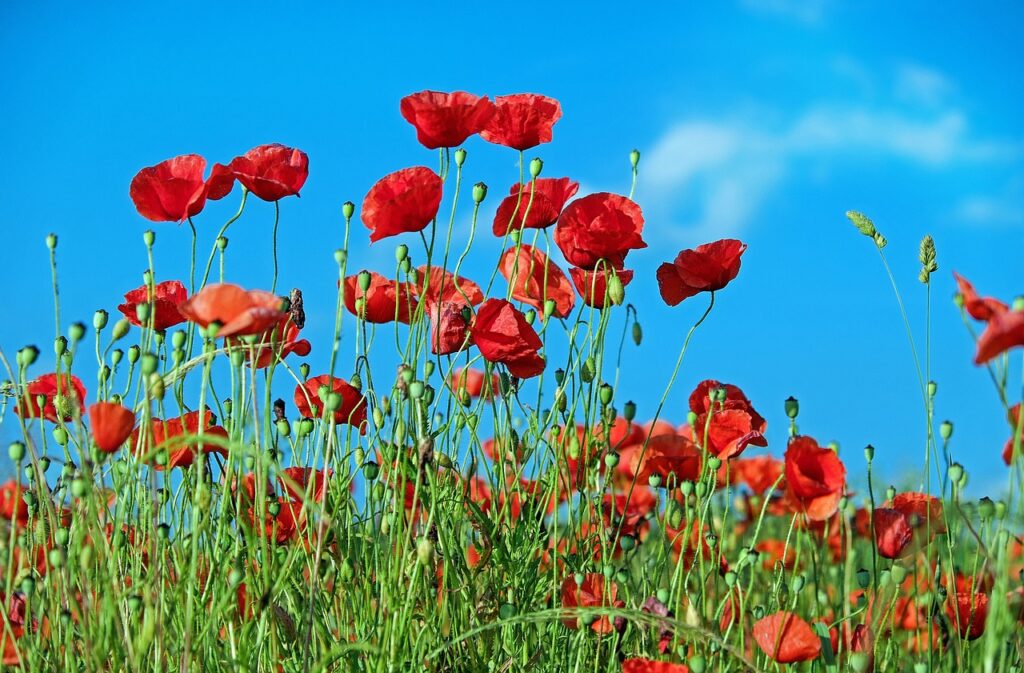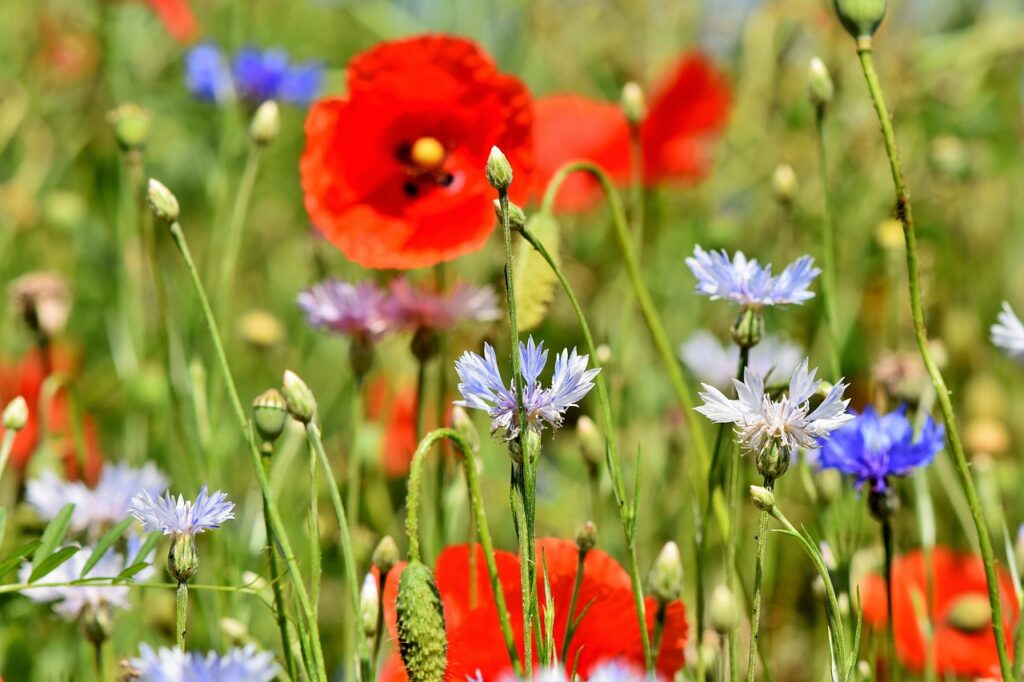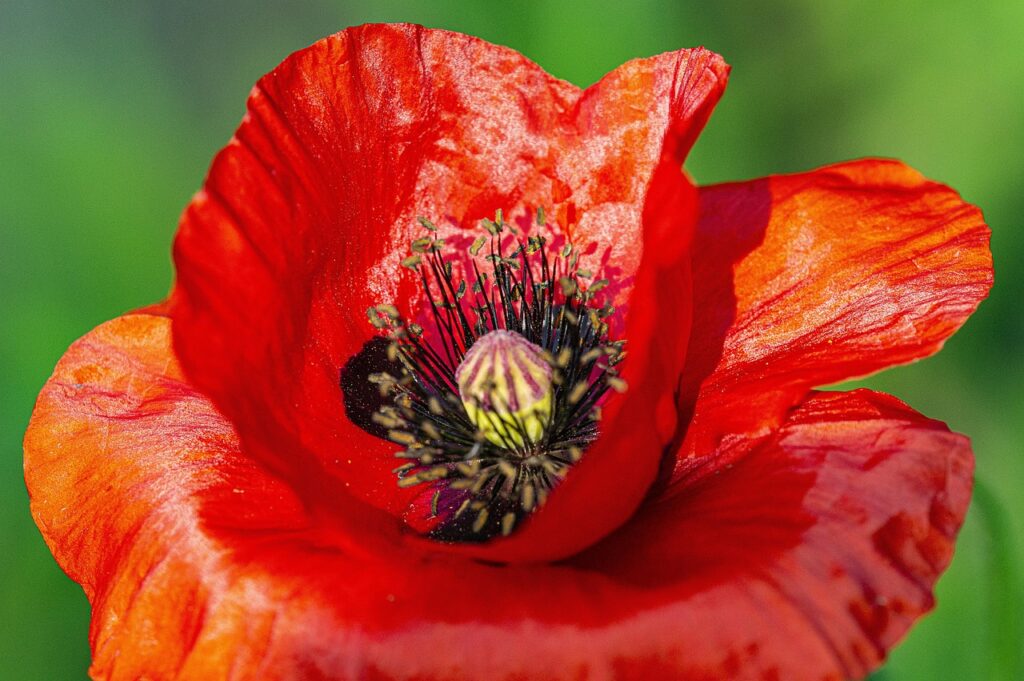The Red Poppy, known scientifically as Papaver rhoeas, is a striking and poignant symbol of remembrance, renowned for its vibrant red flowers. Growing red poppy from seed is important for its historical significance as well as its vivid color.
This annual plant typically reaches a height of 12 to 30 inches and spreads about 10 to 12 inches, creating an eye-catching display of delicate, tissue-paper-like blooms.
Native to Europe and parts of Asia, the Red Poppy thrives in a variety of climates and is well-suited to USDA Hardiness Zones 3 through 9.
These resilient flowers prefer full sun exposure and well-drained soil, and they’re known for their ability to self-seed and naturalize in favorable conditions, making them an excellent choice for wildflower gardens, meadows, and informal garden borders.
When to Grow Red Poppy from Seed

The timing for sowing Red Poppy seeds depends on your specific USDA Hardiness Zone:
In Zones 3-5
Sow Red Poppy seeds directly into the garden as soon as the soil can be worked in early spring. In these cooler zones, the seeds will benefit from the cold period prior to sprouting as the weather warms.
In Zones 6-8
The ideal time to sow Red Poppy seeds is in early spring when the danger of frost has passed. You can also sow in late fall; the seeds will lie dormant over winter and germinate in the spring.
In Zones 9-12
In these warmer regions, Red Poppy seeds can be sown in the fall for winter blooms or in early spring. The mild winters allow for a longer growing and blooming period.
Red Poppies are known for their hardiness and ability to grow in various conditions, making them a versatile choice for many gardeners.
How to Prepare Garden Bed for Planting Red Poppy

Preparing the right environment is crucial for the successful growth of Red Poppy (Papaver rhoeas). Here’s a step-by-step guide to ensure your garden bed is ready for these beautiful flowers:
Choosing a Location
Red Poppies thrive best in full sun. Choose a spot in your garden that receives at least 6-8 hours of direct sunlight each day. Adequate sun exposure is essential for vibrant blooms and healthy growth.
These flowers prefer well-drained soil. While Red Poppies can tolerate a range of moisture conditions, they do not fare well in waterlogged soils. A location that allows for good drainage will prevent root rot and other moisture-related issues.
Red Poppies are adaptable to various soil types but flourish in loose, well-draining soil. They prefer a neutral to slightly acidic pH. If your soil is heavy or clay-like, consider amending it with sand or organic matter to improve drainage. Adding compost can also enhance soil fertility and structure.
Preparing the Garden Bed

Start by removing weeds, stones, and debris from the planting area. This preparation helps eliminate competition for nutrients and water.
Loosen the soil gently with a garden fork if the bed is compacted. This step improves aeration and drainage, which are key for healthy poppy growth. Add a layer of compost if the soil is poor.
Use a rake to even out the soil surface. This ensures uniform seed sowing and consistent growth conditions across the bed.
Before sowing seeds, lightly water the prepared bed. Moist soil will provide an ideal environment for the seeds to germinate.
Direct Sowing Red Poppy

Directly sowing Red Poppy (Papaver rhoeas) seeds in the garden is a simple yet rewarding process. Here’s how to ensure successful sowing:
Depth to Plant
Sow Red Poppy seeds very shallowly, just below the surface of the soil, about 1/8 inch deep. A light dusting of soil over the seeds is sufficient. This shallow planting depth allows for adequate light exposure, which is necessary for germination.
Spacing
Scatter the seeds evenly over the prepared area, or if you prefer a more organized look, sow them in rows. When scattering, don’t worry too much about spacing, as Red Poppies can be thinned out later. If sowing in rows, space the rows about 6-8 inches apart.
Watering In After Planting
After sowing, water the area gently but thoroughly to moisten the soil. Use a watering can with a fine rose or a gentle spray setting to avoid disturbing the seeds. The goal is to keep the soil consistently moist but not waterlogged until germination occurs.
Thinning
Once the seedlings emerge and reach a height of a couple of inches, thin them to about 6-8 inches apart. Proper thinning ensures that each plant has enough space to grow and receive adequate sunlight and nutrients, leading to healthier and more robust flowers.
Mulching
Applying a thin layer of organic mulch around the seedlings can help retain soil moisture, regulate soil temperature, and suppress weed growth. However, be cautious with mulching young seedlings; a light layer is enough, as heavy mulching can overwhelm them.
Tips and Tricks for Growing Red Poppy

Successfully cultivating Red Poppy (Papaver rhoeas) involves understanding and catering to their specific needs. Here are some tips and tricks to help you grow these beautiful flowers:
Sunlight is Key
Red Poppies flourish in full sun. Plant them in a spot that receives at least 6-8 hours of direct sunlight daily to ensure healthy growth and abundant blooming.
Watering Requirements
These flowers prefer a well-draining soil and do not like to be waterlogged. Water them regularly during the initial growth period, but once established, they are quite drought-tolerant. Allow the soil to dry out slightly between waterings.
Avoid Transplanting
Red Poppies have sensitive root systems and generally don’t respond well to transplanting. It’s best to sow the seeds directly in their final location.
Fertilization
Lightly fertilize your Red Poppies, if at all. Rich soil or over-fertilization can lead to lush foliage but fewer blooms. A balanced, general-purpose fertilizer applied sparingly at the start of the season is usually adequate.
Deadheading
To encourage continuous blooming, deadhead the spent flowers. This means removing the faded blooms before they set seed, which encourages the plant to produce more flowers.
Self-Seeding
Red Poppies can self-seed prolifically. After the flowering season, you can leave some spent blooms on the plants to allow them to drop seeds for the next season’s growth.
Thinning Seedlings
If you’ve directly sown the seeds, thin the seedlings to give each plant enough space to grow. This improves air circulation and overall plant health.
How to Harvest Red Poppy Seeds for Replanting

Harvesting seeds from Red Poppy (Papaver rhoeas) allows you to replant these beautiful flowers the following season. Here’s how to collect their seeds:
After the flowers have bloomed, wait for the seed pods to form and dry out. They will turn a light brown color and feel dry to the touch.
Carefully cut or snap off the dry pods from the plant. Be gentle to avoid spilling the tiny seeds inside.
Over a bowl or paper, gently shake or tap the pods. The small, round seeds should fall out easily.
Store the seeds in a cool, dry place. An envelope or airtight container is ideal for storage. Label the container with the date and type of seeds.
When you’re ready to replant, sow the seeds directly in the garden as per the recommended planting guidelines.
What to Expect from Red Poppy Over Winter

Red Poppy plants, being annuals, will complete their life cycle within a single growing season. Here’s what you can expect as winter approaches:
After flowering and seeding, Red Poppy plants will naturally die off.
If you leave some seed pods on the plants, they may self-seed in the garden. These seeds can lie dormant through winter and sprout the following spring.
As annuals, Red Poppies do not survive over winter and will not regrow from the same plant the next season.
Growing Red Poppy from Seed

Growing Red Poppy from seed is a rewarding gardening endeavor. These striking flowers not only add a splash of vibrant color to your garden but also hold significant historical and symbolic value.
By understanding the proper sowing techniques, care requirements, and seed harvesting methods, you can enjoy the beauty of Red Poppies year after year.





